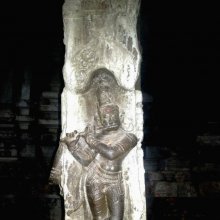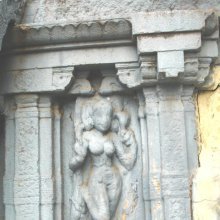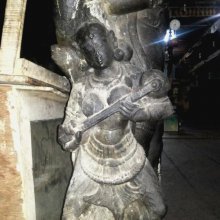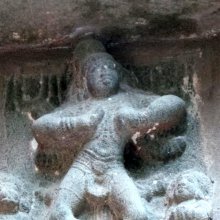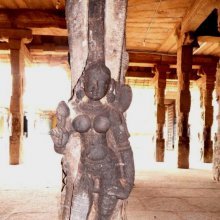Jangha, Jaṅghā, Jaṅgha, Jana-ogha, Jamgha: 30 definitions
Introduction:
Jangha means something in Buddhism, Pali, Hinduism, Sanskrit, the history of ancient India, Marathi, Jainism, Prakrit, Hindi. If you want to know the exact meaning, history, etymology or English translation of this term then check out the descriptions on this page. Add your comment or reference to a book if you want to contribute to this summary article.
Images (photo gallery)
(+127 more images available)
In Hinduism
Shilpashastra (iconography)
Source: Google Books: The Theory of Citrasutras in Indian PaintingAccording to the Matsya Purāṇa, Jaṅgha (leg) from knee to ankle is 24 aṅgulas.

Shilpashastra (शिल्पशास्त्र, śilpaśāstra) represents the ancient Indian science (shastra) of creative arts (shilpa) such as sculpture, iconography and painting. Closely related to Vastushastra (architecture), they often share the same literature.
Vastushastra (architecture)
Source: Wisdom Library: Vāstu-śāstraJaṅghā (जङ्घा) is another name (synonym) for stambha, a Sanskrit technical term referring to “pillar”. These synonyms are defined in texts such as Mayamata (verse 15.2), Mānasāra (verse 15.2-3), Kāśyapaśilpa (verse 8.2) and Īśānaśivagurudevapaddati (Kriya, verses 31.19-20).
Source: Brill: Śaivism and the Tantric Traditions (architecture)Jaṅghā (जङ्घा) refers to the “shanks”, according to the Devyāmata (in the section śalyoddhāra-paṭala or “excavation of extraneous substances”).—Accordingly, “[...] If [someone] is seen to scratch his knee, there is an extraneous thing, i.e. a stump or a knee bone at a depth of one cubit. [The officiant] should remove it. If [someone] touches his shank (jaṅghā—yadā saṃspṛśyate jaṅghāṃ), [the officiant] should prognosticate a bone of the shank (jaṅghāsthi) [at a depth of] eleven digits underground in that place. There is no doubt about this. [...]”.

Vastushastra (वास्तुशास्त्र, vāstuśāstra) refers to the ancient Indian science (shastra) of architecture (vastu), dealing with topics such architecture, sculpture, town-building, fort building and various other constructions. Vastu also deals with the philosophy of the architectural relation with the cosmic universe.
Natyashastra (theatrics and dramaturgy)
Source: Wisdom Library: Nāṭya-śāstraJaṅghā (जङ्घा ) refers to “shank” (the part of leg which stretches from the ankle to the knee). It is one of the parts of the human body with which gestures (āṅgika) are performaned, according to the Nāṭyaśāstra chapter 10. These gestures form a part of the histrionic representation (abhinaya).
There are five different ‘movements of the shank (jaṅghā)’ defined:
- āvartita (turned),
- nata (bent),
- kṣipta (thrown out),
- udvāhita (raised),
- parivṛtta (turned back).

Natyashastra (नाट्यशास्त्र, nāṭyaśāstra) refers to both the ancient Indian tradition (shastra) of performing arts, (natya—theatrics, drama, dance, music), as well as the name of a Sanskrit work dealing with these subjects. It also teaches the rules for composing Dramatic plays (nataka), construction and performance of Theater, and Poetic works (kavya).
Purana and Itihasa (epic history)
Source: JatLand: List of Mahabharata people and placesJaṅgha (जङ्घ) is a name mentioned in the Mahābhārata (cf. XIII.4.51, XIII.4) and represents one of the many proper names used for people and places. Note: The Mahābhārata (mentioning Jaṅgha) is a Sanskrit epic poem consisting of 100,000 ślokas (metrical verses) and is over 2000 years old.

The Purana (पुराण, purāṇas) refers to Sanskrit literature preserving ancient India’s vast cultural history, including historical legends, religious ceremonies, various arts and sciences. The eighteen mahapuranas total over 400,000 shlokas (metrical couplets) and date to at least several centuries BCE.
Ayurveda (science of life)
Source: gurumukhi.ru: Ayurveda glossary of termsJaṅghā (जङ्घा):—Foreleg

Āyurveda (आयुर्वेद, ayurveda) is a branch of Indian science dealing with medicine, herbalism, taxology, anatomy, surgery, alchemy and related topics. Traditional practice of Āyurveda in ancient India dates back to at least the first millenium BC. Literature is commonly written in Sanskrit using various poetic metres.
Shaktism (Shakta philosophy)
Source: Google Books: ManthanabhairavatantramJaṅgha (जङ्घ) [=Jaṅghana?] refers to “thighs”, according to the Manthānabhairavatantra, a vast sprawling work that belongs to a corpus of Tantric texts concerned with the worship of the goddess Kubjikā.—Accordingly, while describing the signs of one who is a Siddha: “His heart is uplifted and his nose and the rest (of his face) is well balanced. The sign of one who is well accomplished is that he is well behaved and he produces abundance. His foot is upraised and his thighs are broad [i.e., vistīrṇa-jaṅghana-sthāna], the forehead is well balanced. He is accomplished from a previous life and is Bhairava. His navel has three creases. His penis is small and auspicious. His body is straight and well proportioned. Such a one is accomplished from a previous life in the western (tradition). His nails are well proportioned and red. His hands bear the marks of elevation and his eyes are red. Such is an accomplished one in the previous lineage. His face is like a lotus and his hair is (tied up in a knot in the) foreign style. One who is such and is equal in pleasure and pain is part of the Siddha lineage”.

Shakta (शाक्त, śākta) or Shaktism (śāktism) represents a tradition of Hinduism where the Goddess (Devi) is revered and worshipped. Shakta literature includes a range of scriptures, including various Agamas and Tantras, although its roots may be traced back to the Vedas.
Shaivism (Shaiva philosophy)
Source: Brill: Śaivism and the Tantric TraditionsJaṅgha (जङ्घ) refers to the “shanks”, according to the 13th-century Matsyendrasaṃhitā: a Kubjikā-Tripurā oriented Tantric Yoga text of the Ṣaḍanvayaśāmbhava tradition from South India.—Accordingly, “[Visualisation of Śakti]:—[...] She is anointed with divine ointments and she is dressed in divine clothes, with her loins exposed. Her thighs and shanks are beautiful (cāru-ūru-jaṅgha). Her body is the ultimate essence of gracefulness. Her feet are embellished with anklets. She wears divine garlands and [has been anointed] with divine ointments. She is delighted by the wine she is enjoying. Her body is filled with passion. She is restless with wantonness. [This is how the Yogin] should visualise his lover as Śakti, O Maheśvarī”.

Shaiva (शैव, śaiva) or Shaivism (śaivism) represents a tradition of Hinduism worshiping Shiva as the supreme being. Closely related to Shaktism, Shaiva literature includes a range of scriptures, including Tantras, while the root of this tradition may be traced back to the ancient Vedas.
Ganitashastra (Mathematics and Algebra)
Source: archive.org: Hindu MathematicsJaṅghā (जङ्घा) represents the number 2 (two) in the “word-numeral system” (bhūtasaṃkhyā), which was used in Sanskrit texts dealing with astronomy, mathematics, metrics, as well as in the dates of inscriptions and manuscripts in ancient Indian literature.—A system of expressing numbers by means of words arranged as in the place-value notation was developed and perfected in India in the early centuries of the Christian era. In this system the numerals [e.g., 2—jaṅghā] are expressed by names of things, beings or concepts, which, naturally or in accordance with the teaching of the Śāstras, connote numbers.

Ganitashastra (शिल्पशास्त्र, gaṇitaśāstra) refers to the ancient Indian science of mathematics, algebra, number theory, arithmetic, etc. Closely allied with astronomy, both were commonly taught and studied in universities, even since the 1st millennium BCE. Ganita-shastra also includes ritualistic math-books such as the Shulba-sutras.
Yoga (school of philosophy)
Source: ORA: Amanaska (king of all yogas): A Critical Edition and Annotated Translation by Jason BirchJaṅghā (जङ्घा) refers to the “shanks”, according to the Mataṅgapārameśvaratantra (Mataṅgapārameśvara’s Yogapāda) verse 2.23-27.—Accordingly, while discussing ancillary and seated poses in Yoga: “[Having adopted either paryaṅka, kamala, bhadra or svastikāsana], the wise [Yogin] places his hands obliquely, in the middle of the shanks (jaṅghā), makes [them] upward-facing and evenly balanced, and fixes the right hand on the left, so that the right fingers are at the base of the left [hand]. The two thumbs are bent slightly and should be held together. [...]”.

Yoga is originally considered a branch of Hindu philosophy (astika), but both ancient and modern Yoga combine the physical, mental and spiritual. Yoga teaches various physical techniques also known as āsanas (postures), used for various purposes (eg., meditation, contemplation, relaxation).
In Buddhism
Mahayana (major branch of Buddhism)
Source: Wisdom Library: Maha Prajnaparamita SastraJaṅghā (जङ्घा, “thigh”) refers to the “two thighs”, from which the Buddha emitted numerous rays when he smiled with his whole body after contemplating the entire universe, according to the 2nd century Mahāprajñāpāramitāśāstra (chapter XIV).—Accordingly, having himself arranged the lion-seat, the Bhagavat sat down cross-legged; holding his body upright and fixing his attention, he entered into the samādhirājasamādhi. Then, having tranquilly come out of this samādhi and having contemplated the entire universe with his divine eye (divyacakṣus), the Bhagavat smiled with his whole body. Wheels with a thousand spokes imprinted on the soles of his feet (pādatala) shoot out six hundred prabhedakoṭi of rays. In the same way, beams of six hundred prabhedakoṭi of rays are emitted from his two thighs (jaṅghā).

Mahayana (महायान, mahāyāna) is a major branch of Buddhism focusing on the path of a Bodhisattva (spiritual aspirants/ enlightened beings). Extant literature is vast and primarely composed in the Sanskrit language. There are many sūtras of which some of the earliest are the various Prajñāpāramitā sūtras.
Tibetan Buddhism (Vajrayana or tantric Buddhism)
Source: OSU Press: Cakrasamvara SamadhiJaṅghā (जङ्घा) refers to the “hips”, according to the Cakrasaṃvara Samādhi [i.e., Cakrasamvara Meditation] ritual often performed in combination with the Cakrasaṃvara Samādhi, which refers to the primary pūjā and sādhanā practice of Newah Mahāyāna-Vajrayāna Buddhists in Nepal.—Accordingly, “[...] Six joyful seals, the foremost of them (being) her holiness, Colored red, with one face, two arms, and three eyes, Naked with loose hair, (and) partly adorned with a girdle, The left arm embracing, holding in a skull bowl, sin and death for eating, On the right a threatening finger pointing in the direction of all defilement, Sounding the thunder of an impending kalpa-fire of great majesty, With the bloody opening (between) both hips (jaṅgha-dvaya) penetrated by (her) hero, One who loves great pleasure, belonging to the nature of compassion”.
Source: MDPI Books: The Ocean of HeroesJaṅghā (जङ्घा) refers to the “shanks”, according to the 10th-century Ḍākārṇava-tantra: one of the last Tibetan Tantric scriptures belonging to the Buddhist Saṃvara tradition consisting of 51 chapters.—Accordingly, “[Vajravārāhī holds] an adamantine knife in the right [hand] and a skull bowl in the left hand; hugs the Blessed One (Heruka) around [his] hips with [her] two shanks (jaṅghā-dvaya) and loves [him]; [has] one face; [has her] hair untied; is naked; is red in color; wears a garland of hairless heads [as a necklace]; is adorned with sexually attractive ornaments; is crowned with a string of skulls on [her] head; [...]”.

Tibetan Buddhism includes schools such as Nyingma, Kadampa, Kagyu and Gelug. Their primary canon of literature is divided in two broad categories: The Kangyur, which consists of Buddha’s words, and the Tengyur, which includes commentaries from various sources. Esotericism and tantra techniques (vajrayāna) are collected indepently.
India history and geography
Source: Cologne Digital Sanskrit Dictionaries: Indian Epigraphical GlossaryJaṅghā.—(HRS), forced service as messenger, as indicated by the Jātakas; also same as Jaṅghākarika. Note: jaṅghā is defined in the “Indian epigraphical glossary” as it can be found on ancient inscriptions commonly written in Sanskrit, Prakrit or Dravidian languages.

The history of India traces the identification of countries, villages, towns and other regions of India, as well as mythology, zoology, royal dynasties, rulers, tribes, local festivities and traditions and regional languages. Ancient India enjoyed religious freedom and encourages the path of Dharma, a concept common to Buddhism, Hinduism, and Jainism.
Languages of India and abroad
Pali-English dictionary
Source: BuddhaSasana: Concise Pali-English Dictionaryjaṅghā : (f.) the lower leg; the calf of the leg.
Source: Sutta: The Pali Text Society's Pali-English DictionaryJaṅghā, (f.) (Vedic jaṅghā; cp. Av. zanga, ankle; Goth. gaggan, to go; Ags. gang, walk. From *gheṅgh to walk; see also jaghana) the leg, usually the lower leg (from knee to ankle) D. II, 17≈(S. I, 16=Sn. 165 (eṇi°); Sn. 610; J. II, 240; V, 42; VI, 34; ThA. 212). In cpds. jaṅgha° (except in jaṅghā-vihāra).

Pali is the language of the Tipiṭaka, which is the sacred canon of Theravāda Buddhism and contains much of the Buddha’s speech. Closeley related to Sanskrit, both languages are used interchangeably between religions.
Marathi-English dictionary
Source: DDSA: The Molesworth Marathi and English Dictionaryjaṅghā (जंघा).—f S pop. and poetically jaṅgha f The thigh or the whole leg. See ex. under jaghana. 2 In popular understanding. The calf of the leg.
--- OR ---
jāṅgha (जांघ).—f (jaṅgha S) The thigh. 2 The groin or pubic region.
Source: DDSA: The Aryabhusan school dictionary, Marathi-Englishjaṅghā (जंघा).—f The thigh or the whole leg.
--- OR ---
jaṅgha (जंघ).—f The thigh or the whole leg.
--- OR ---
jāṅgha (जांघ).—f The thigh. The groin.
Marathi is an Indo-European language having over 70 million native speakers people in (predominantly) Maharashtra India. Marathi, like many other Indo-Aryan languages, evolved from early forms of Prakrit, which itself is a subset of Sanskrit, one of the most ancient languages of the world.
Sanskrit dictionary
Source: DDSA: The practical Sanskrit-English dictionaryJaṅghā (जङ्घा).—[jaṅghanyate kuṭilaṃ gacchati han yaṅ luki ac pṛṣo°; cf. Uṇādi-sūtra 5.31]
1) Leg from the ankle to the knee, the shank.
2) The upper part of the leg, the part about the loins.
3) A part of a bed-stead.
--- OR ---
Jangha (जन्घ).—a concourse of people, crowd, mob.
Derivable forms: janghaḥ (जन्घः).
Jangha is a Sanskrit compound consisting of the terms jana and ogha (ओघ).
Source: Cologne Digital Sanskrit Dictionaries: Edgerton Buddhist Hybrid Sanskrit DictionaryJaṅghā (जङ्घा).—name of a (tantalizing) state of preta-existence: Śikṣāsamuccaya 57.6.
Source: Cologne Digital Sanskrit Dictionaries: Shabda-Sagara Sanskrit-English DictionaryJaṅghā (जङ्घा).—f.
(-ṅghā) The leg. E. jan to be born, jaṅgha substituted for the radical, and ac aff. jaṅghanyate kuṭilaṃ gacchati gatyarthakasya hanteḥ kauṭilye yaṅluki ac pṛṣo0 .
Source: Cologne Digital Sanskrit Dictionaries: Benfey Sanskrit-English DictionaryJaṅghā (जङ्घा).—i. e. reduplicated han + a, fem. The leg, [Suśruta] 1, 348, 15.
Source: Cologne Digital Sanskrit Dictionaries: Cappeller Sanskrit-English DictionaryJaṅghā (जङ्घा).—[feminine] leg, [especially] its under [particle]
Source: Cologne Digital Sanskrit Dictionaries: Monier-Williams Sanskrit-English Dictionary1) Jaṅgha (जङ्घ):—m. Name of a Rakṣas, [Rāmāyaṇa vi, 69, 12]
2) Jaṅghā (जङ्घा):—[from jaṅgha] a f. (√jaṃh) the shank (from the ankle to the knee), [Ṛg-veda i, 116, 15 and 118, 8; Atharva-veda; Vājasaneyi-saṃhitā] etc. (ifc. [Pāṇini 6-2, 144]; f(ā). , [Śrutabodha]; also f(ī). , [Pāṇini 4-1, 55])
3) [v.s. ...] the leg
4) [v.s. ...] a part of a bedstead, [Varāha-mihira’s Bṛhat-saṃhitā lxxix, 30]
5) [v.s. ...] of a carriage See ratha-.
6) [v.s. ...] b f. See sub voce gha.
Source: Cologne Digital Sanskrit Dictionaries: Yates Sanskrit-English DictionaryJaṅghā (जङ्घा):—(ṅghā) 1. f. The leg.
Source: DDSA: Paia-sadda-mahannavo; a comprehensive Prakrit Hindi dictionary (S)Jaṅghā (जङ्घा) in the Sanskrit language is related to the Prakrit word: Jaṃghā.
[Sanskrit to German]
Sanskrit, also spelled संस्कृतम् (saṃskṛtam), is an ancient language of India commonly seen as the grandmother of the Indo-European language family (even English!). Closely allied with Prakrit and Pali, Sanskrit is more exhaustive in both grammar and terms and has the most extensive collection of literature in the world, greatly surpassing its sister-languages Greek and Latin.
Hindi dictionary
Source: DDSA: A practical Hindi-English dictionaryJangha in Hindi refers in English to:—(nf) a thigh..—jangha (जंघा) is alternatively transliterated as Jaṃghā.
...
Prakrit-English dictionary
Source: DDSA: Paia-sadda-mahannavo; a comprehensive Prakrit Hindi dictionaryJaṃghā (जंघा) in the Prakrit language is related to the Sanskrit word: Jaṅghā.
Prakrit is an ancient language closely associated with both Pali and Sanskrit. Jain literature is often composed in this language or sub-dialects, such as the Agamas and their commentaries which are written in Ardhamagadhi and Maharashtri Prakrit. The earliest extant texts can be dated to as early as the 4th century BCE although core portions might be older.
See also (Relevant definitions)
Starts with (+28): Jamghalamghita, Jamghalatana, Jamghavarta, Janghabala, Janghabalam, Janghabandhu, Janghabhara, Janghabhovari, Janghacarana, Janghacharana, Janghada, Janghadasa, Janghadvaya, Janghajaghanya, Janghajoda, Janghakanda, Janghakara, Janghakarika, Janghakarikara, Janghakashyapa.
Ends with (+19): Agrajangha, Aineyajangha, Anujangha, Ardhajangha, Bhandijangha, Carjujangha, Dhulijangha, Dhvankshajangha, Dirghajangha, Dvijangha, Enajangha, Janujangha, Kakajangha, Kharajangha, Kharijangha, Lohajangha, Mahajangha, Mayurajangha, Nadijangha, Nalijangha.
Full-text (+139): Janghatrana, Agrajangha, Janghakarika, Dirghajangha, Janghala, Nalijangha, Shuddhajangha, Pratijangha, Kakajangha, Janghabala, Janghika, Janghi, Kharijangha, Janghakara, Nadijangha, Jamgha, Janghaprahrita, Janghanalaka, Janghavihara, Janghaprahata.
Relevant text
Search found 32 books and stories containing Jangha, Jaṅghā, Jaṅgha, Jana-ogha, Jamgha, Jāṅgha, Jaṃghā; (plurals include: Janghas, Jaṅghās, Jaṅghas, oghas, Jamghas, Jāṅghas, Jaṃghās). You can also click to the full overview containing English textual excerpts. Below are direct links for the most relevant articles:
Rig Veda (translation and commentary) (by H. H. Wilson)
List of Mahabharata people and places (by Laxman Burdak)
Jain Remains of Ancient Bengal (by Shubha Majumder)
Abandoned Temples/Structural Ruins Containing Sculptural Specimens < [Chapter 5 - Jaina Architectural and Sculptural Remains]
Jain Caumukha/Caumukhi or Caturmukhas < [Chapter 6 - Iconographic Study of Jaina Sculptural Remains]
Jivanandana of Anandaraya Makhin (Study) (by G. D. Jayalakshmi)
Jvara (fever) < [Chapter 4 - Āyurvedic principles in Jīvanandana Nāṭaka]
Jainism in Odisha (Orissa) (by Ashis Ranjan Sahoo)
Jaina Antiquities at Budhapada (Khordha) < [Chapter 3: Survey of Jaina Antiquities in Odisha]
Structural Architecture < [Chapter 4]
Mahabharata (English) (by Kisari Mohan Ganguli)
Section XXXIV < [Abhimanyu-badha Parva]
Section XLIX < [Sisupala-badha Parva]
Section CII < [Rajadharmanusasana Parva]
